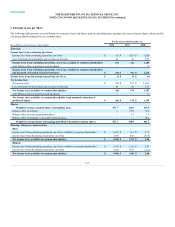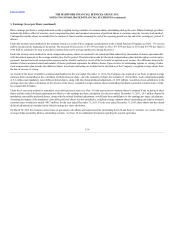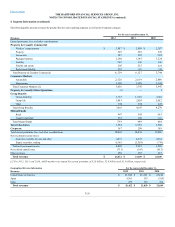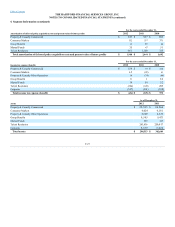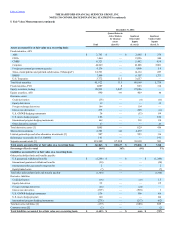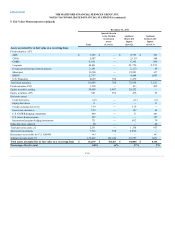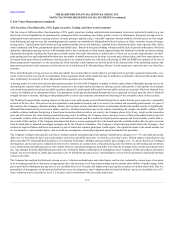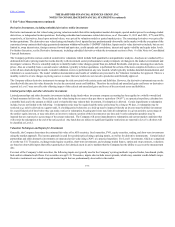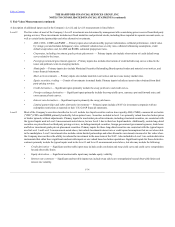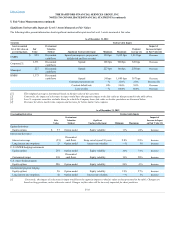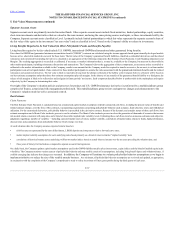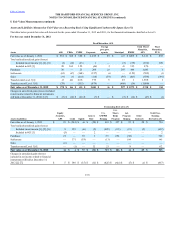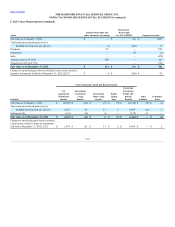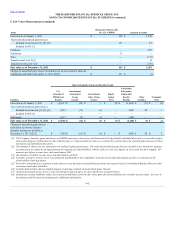The Hartford 2012 Annual Report Download - page 174
Download and view the complete annual report
Please find page 174 of the 2012 The Hartford annual report below. You can navigate through the pages in the report by either clicking on the pages listed below, or by using the keyword search tool below to find specific information within the annual report.
Table of Contents
AFS Securities, Fixed Maturities, FVO, Equity Securities, Trading, and Short-term Investments
The fair value of AFS securities, fixed maturities, FVO, equity securities, trading, and short-term investments in an active and orderly market (e.g. not
distressed or forced liquidation) are determined by management after considering one of three primary sources of information: third-party pricing services,
independent broker quotations or pricing matrices. Security pricing is applied using a “waterfall” approach whereby publicly available prices are first sought
from third-party pricing services, the remaining unpriced securities are submitted to independent brokers for prices, or lastly, securities are priced using a
pricing matrix. Typical inputs used by these pricing methods include, but are not limited to, reported trades, benchmark yields, issuer spreads, bids, offers,
and/or estimated cash flows, prepayments speeds and default rates. Based on the typical trading volumes and the lack of quoted market prices for fixed
maturities, third-party pricing services will normally derive the security prices from recent reported trades for identical or similar securities making
adjustments through the reporting date based upon available market observable information as outlined above. If there are no recently reported trades, the third-
party pricing services and independent brokers may use matrix or model processes to develop a security price where future cash flow expectations are
developed based upon collateral performance and discounted at an estimated market rate. Included in the pricing of ABS and RMBS are estimates of the rate of
future prepayments of principal over the remaining life of the securities. Such estimates are derived based on the characteristics of the underlying structure and
prepayment speeds previously experienced at the interest rate levels projected for the underlying collateral. Actual prepayment experience may vary from these
estimates.
Prices from third-party pricing services are often unavailable for securities that are rarely traded or are traded only in privately negotiated transactions. As a
result, certain securities are priced via independent broker quotations which utilize inputs that may be difficult to corroborate with observable market based
data. Additionally, the majority of these independent broker quotations are non-binding.
A pricing matrix is used to price private placement securities for which the Company is unable to obtain a price from a third-party pricing service by
discounting the expected future cash flows from the security by a developed market discount rate utilizing current credit spreads. Credit spreads are developed
each month using market based data for public securities adjusted for credit spread differentials between public and private securities which are obtained from
a survey of multiple private placement brokers. The appropriate credit spreads determined through this survey approach are based upon the issuer’s financial
strength and term to maturity, utilizing an independent public security index and trade information and adjusting for the non-public nature of the securities.
The Working Group performs ongoing analysis of the prices and credit spreads received from third parties to ensure that the prices represent a reasonable
estimate of the fair value. This process involves quantitative and qualitative analysis and is overseen by investment and accounting professionals. As a part of
this analysis, the Company considers trading volume, new issuance activity and other factors to determine whether the market activity is significantly
different than normal activity in an active market, and if so, whether transactions may not be orderly considering the weight of available evidence. If the
available evidence indicates that pricing is based upon transactions that are stale or not orderly, the Company places little, if any, weight on the transaction
price and will estimate fair value utilizing an internal pricing model. In addition, the Company ensures that prices received from independent brokers represent
a reasonable estimate of fair value through the use of internal and external cash flow models developed based on spreads, and when available, market indices.
As a result of this analysis, if the Company determines that there is a more appropriate fair value based upon the available market data, the price received
from the third party is adjusted accordingly and approved by the Valuation Committee. The Company’s internal pricing model utilizes the Company’s best
estimate of expected future cash flows discounted at a rate of return that a market participant would require. The significant inputs to the model include, but
are not limited to, current market inputs, such as credit loss assumptions, estimated prepayment speeds and market risk premiums.
The Company conducts other specific activities to monitor controls around pricing. Daily analyses identify price changes over 3-5%, sale trade prices that
differ over 3% from the prior day’s price and purchase trade prices that differ more than 3% from the current day’s price. Weekly analyses identify prices that
differ more than 5% from published bond prices of a corporate bond index. Monthly analyses identify price changes over 3%, prices that haven’t changed,
missing prices and second source validation on most sectors. Analyses are conducted by a dedicated pricing unit who follows up with trading and investment
sector professionals and challenges prices with vendors when the estimated assumptions used differ from what the Company feels a market participant would
use. Any changes from the identified pricing source are verified by further confirmation of assumptions used. Examples of other procedures performed
include, but are not limited to, initial and on-going review of third-party pricing services’ methodologies, review of pricing statistics and trends and back
testing recent trades.
The Company has analyzed the third-party pricing services’ valuation methodologies and related inputs, and has also evaluated the various types of securities
in its investment portfolio to determine an appropriate fair value hierarchy level based upon trading activity and the observability of market inputs. Most
prices provided by third-party pricing services are classified into Level 2 because the inputs used in pricing the securities are market observable. Due to a
general lack of transparency in the process that brokers use to develop prices, most valuations that are based on brokers’ prices are classified as Level 3.
Some valuations may be classified as Level 2 if the price can be corroborated with observable market data.
F-32


